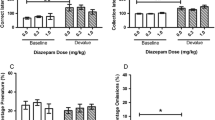Abstract
Numerous “second-generation” antidepressants with pharmacological profiles and chemical structures different from those of the tricyclic antidepressants have recently been developed. We examined the actions of four of these compounds (mianserin, maprotiline, trazodone and fluvoxamine) on the responding of pigeons under two different multiple (mult) schedules of grain presentation (a mult fixed-interval (FI) 600-s fixed-ratio (FR) 30-response and a mult FI 200-s FI 200-s in which responding in one component was punished by intermittent presentation of a brief electric shock). The rate of FI 600-s responding was greatly increased by several doses of maprotiline and mianserin, which either did not affect or produced only small increases in the rate of FR 30 responding. Fluvoxamine and trazodone did not produce similar differential effects. Relatively low doses of maprotiline, mianserin and trazodone decreased the FI quarter-lifes. Fluvoxamine only decreased the FI quarter-life at a dose that largely eliminated responding. Mianserin produced proportionally greater increases in the rate of punished FI 200-s responding than in the rate of unpunished FI 200-s responding. Selective effects on punished responding were not seen with maprotiline, fluvoxamine and trazodone.
Similar content being viewed by others
References
Azrin NH (1959) A technique for delivering shock to pigeons. J Exp Anal Behav 2:161–163
Brogden RW, Heel RC, Speight TM, Avery GS (1978) Mianserin: A review of its pharmacological properties and therapeutic efficacy in depressive illness. Drugs 16:273–301
Chait LD, Wenger GR, McMillan DE (1981) Effects of phencyclidine and ketamine on punished and unpunished responding by pigeons. Pharmacol Biochem Behav 15(1):145–148
Dews PB (1962) A behavioral output enhancing effect of imipramine in pigeons. Int J Neuropharmacol 1:265–272
Doogan DP (1980) Fluvoxamine as an antidepressant drug. Neuropharmacology 19:1215–1216
Ferster CB, Skinner BF (1957) Schedules of reinforcement. Prentice Hall, Englewood Cliffs, New Jersey
Frankhuyzen AL, Bonta IL (1974) Effect of mianserin, a potent anti-serotonin agent, on the isolated rate stomach fundus preparation. Eur J Pharmacol 25:40–50
Fuller RW (1981) Enhancement of monaminergic neurotransmission by antidepressant drugs. In: Enna SJ, Malick JB, Richelson E (eds) Antidepressants: Neurochemical, behavioral and clinical prespectives, Raven Press, New York
Graeff FG (1974) Tryptamine antagonists and punished behavior. J Pharmacol Exp Ther 189:344–350
Graeff FG, Schoenfeld RI (1970) Tryptaminergic mechanisms in punished and nonpunished behavior. J Pharmacol Exp Ther 173:277–283
Hernstein RJ, Morse WH (1957) Effects of pentobarbital on intermittently reinforced behavior. Science 125:929–931
Iversen LL, MacKay AVP (1979) Pharmacodynamics of antidepressant and antimanic drugs. In: Paykel ES, Coppen A (eds) Psychopharmacology of affective disorders, Oxford University Press, Oxford
Koe BK (1976) Molecular geometry of inhibitory of the uptake of catecholamines and serotonin in synaptosomal preparation of rat brain. J Pharmacol Exp Ther 199:649–661
Lamb RJ, McMillan DE (1985) Some effects of chlorimipramine and imipramine on the schedule-controlled behavior of the pigeon. Psychopharmacology (in press)
Leander JD (1981) Antagonism of oxotremorine-induced behavioral suppression by antimuscarinic drugs. Psychopharmacology 75:5–8
Leander JD, Carter RB (1984) Effects of norepinephrine and serotonin uptake inhibitors on the schedule-controlled behavior of the pigeon. Pharmacol Biochem Behav 20:391–395
Maître L, Staehelin M, Bein HJ (1971) Blockade of noradrenaline uptake by 34276-Ba, a new antidepressant drug. Biochem Pharmacol 20:2169–2186
Maître L, Waldmeier PC, Baumann PA, Staehlein M (1974) Effect of Maprotiline, a new antidepressant drug, on serotonin uptake. Adv Biochem Psychopharmacol 10:297–304
McGuire PS, Seiden LS (1980a) The effects of tricyclic antidepressants on performance under a differential-reinforcement-of-low-rates schedule in rats. J Pharmacol Exp Ther 214:635–641
McGuire PS, Seiden LS (1980b) Differential effects of imipramine in rats as a function of DRL schedule value. Pharmacol Biochem Behav 13:691–694
McKearney JW (1981) Individual differences in effects of tricyclic antidepressants and anticholinergic on operant behavior in the squirrel monkey. Life Sci 28:2047–2054
McKearney JW (1982a) Effects of tricyclic antidepressants and anticholinergic drugs on fixed-interval responding in the squirrel monkey. J Pharmacol Exp Ther 222:215–219
McKearney JW (1982b) Effects of dopamine uptake inhibitors on schedule-controlled behavior in the squirrel monkey. Psychopharmacology 78:377–379
McMillan DE (1973) Drugs and punished responding. I. Rate-dependent effects under multiple schedules. J Exp Anal Behav 19:133–145
Morse WH (1964) Effects of amobarbital and chlorpromazine on punished behavior in the pigeon. Psychopharmacologia 6:19–28
Murphy JE (1978) Mianserin in the treatment of depressive illness and anxiety states in general pratice. Br J Clin Pharmacol 5:81S-85S
O'Donnell JM, Seiden LS (1983) Differential-reinforcement of low-rate 72-second schedule: Selective effects of antidepressant drugs. J Pharmacol Exp Ther 224:80–88
Rastogi SK, McMillan DE (1985) Effects of some typical and atypical antidepressants on schedule-controlled responding in rats. Drug Dev Res 5:243–250
Robson RD, Antonaccio MJ, Saelens JK, Liebman J (1978) Antagonism by mianserin and classical alpha-adrenoceptor blocking drugs of some cardiovascular and behavioral effects of clonidine. Eur J Pharmacol 47:431–442
Shopsin B, Cassano GB, Conti L (1981) An overview of new “second generation” antidepressant compounds: Research and treatment implications. In: Enna SJ, Malick JB, Richelson E (eds) Antidepressants: Neurochemical, behavioral, and clinical prespectives
Silvestrini B (1982) Trazodone-A new type of antidepressant: A discussion of pharmacological data and their clinical implications. Adv Biochem Psychopharmacol 31:327–340
Smith CB (1964) Effects of d-amphetamine upon operant behavior of pigeons: Enhancement by reserpine. J Pharmacol Exp Ther 146:167–174
Vaillant GE (1967) A comparison of antagonists of physostigmine-induced suppression of behavior. J Pharmacol Exp Ther 157:636–648
Vargaftig BB, Coignet JL, de Vos CJ, Grigsen H, Bonta IL (1971) Mianserin hydrochloride: Peripheral and central effects in relation to antagonism against 5-hydroxytryptamine and tryptamine. Eur J Pharmacol 16:336–345
Wong DT, Bymaster FP, Reid LR, Threlkeld PG (1983) Fluoxetine and two other serotonin uptake inhibitors without affinity for neuronal receptors. Biochem Pharmacol 32:1287–1293
Zuccarelli RR, Barrett JE (1980) A comparison of the effects of d-amphetamine, cocaine, imipramine and pentobarbital on local and overall rates of responding maintained under a four component multiple fixed-interval schedule. Pharmacol Biochem Behav 12:899–907
Author information
Authors and Affiliations
Rights and permissions
About this article
Cite this article
Lamb, R.J., McMillan, D.E. The effects of some putative antidepressant agents on the schedule-controlled behavior of the pigeon. Psychopharmacology 88, 368–373 (1986). https://doi.org/10.1007/BF00180840
Received:
Revised:
Issue Date:
DOI: https://doi.org/10.1007/BF00180840




